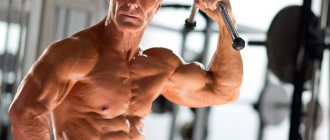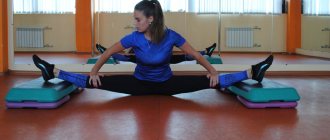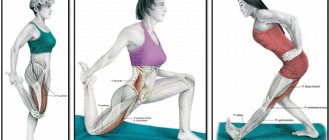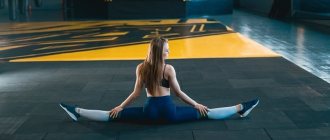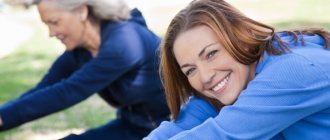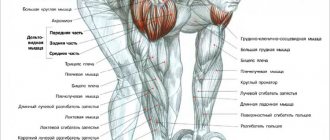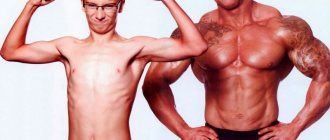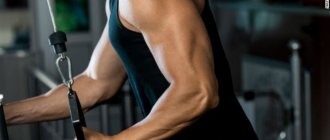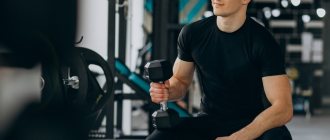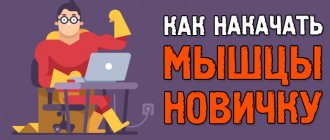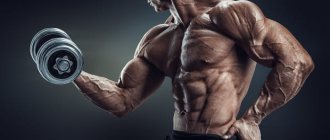Muscles after 50 are influenced by genetics and lifestyle.
By lifestyle you need to understand your sports background and bad habits.
It often happens that a person in his youth spent ten years playing sports to the level of a master, and then for thirty years he drank, overeated and walked only between the sofa, the armchair and the toilet.
Thirty years of bad habits can easily ruin ten years of elite sport. Prominent examples include distinguished sports coaches and physical education teachers. Moreover, the more honored the coach or teacher, the worse the appearance.
On the contrary, thirty years of bad habits can be corrected by three years of training and look better at fifty than at thirty, working as a priest in a temple or as a manager in an office, without having anything to do with the sports and fitness industries. There are also such examples among my clients.
Program for effective muscle growth
The growth of muscle fibers is stimulated by controlled damage that occurs as a result of specific exercises. Recovery occurs during sleep, but only if the person adheres to the correct diet.
Basic principles of the training process for those who want to pump up at 50 years old:
- Alternating loads. Older men The number of repetitions when working with heavy weights should vary from 5 to 12, with light weights - from 12 to 20. This load is enough to gain muscle mass. The duration of the workout should not exceed 1 hour. The cardiovascular system should not be overloaded.
- Load control. Exercises must be performed technically competently, and the weight must be selected correctly, since joint mobility decreases in old age. Breathing requires special attention. Therefore, you need to train only under the supervision of a specialist.
- Recovery. With age, recovery processes slow down, so you need to pay more attention to rest. In the absence of ailments and fatigue, a break of 2 days between workouts is quite enough.
- Diet. It must comply with the principles of a healthy diet and be formed taking into account the age and needs of the body. It is important to get a sufficient amount of carbohydrates before training, which are a source of energy and stimulate muscle growth. Otherwise, it is very difficult to build muscle mass.
Interesting articles:
Squats with a barbell on the shoulders - technique
How to restore license plates on a car
Age nuances
By the age of five, a woman’s body, as they say, is no longer the same: the muscles become sluggish, the bones are weakened, and it is difficult to lose weight. Changes occur both externally and internally:
- the stomach begins to work more slowly;
- food tastes different;
- muscle mass is lost, the percentage of fat increases;
- there is little physical activity, the lifestyle is almost passive;
- internal organs are malfunctioning: the heart is acting up, the joints are aching, vision and hearing are decreasing.
This often occurs against a background of apathy, feelings of loneliness, boredom and indifference.
If you clearly know what is happening to your body, isn’t this an incentive to make changes in your life? “Make friends” with sports to improve your well-being, strengthen your health and feel a surge of strength and energy.
Physical exercise for women after 50 is the key to the door behind which the aging process is suspended. Moreover, in the modern world the choice of these “keys” is wide: walking, swimming, yoga and many other sports activities that will appeal to the soul and become pleasant to the body. By the way, menopause is not a hindrance to this at all.
Climax
After 45 years, a woman’s body begins to undergo significant hormonal changes. There is a reduction in the amount of estrogen, which stimulates and regulates metabolism. Weight is gained even if the caloric content of food remains the same.
During menopause, extra pounds are accompanied by health complications: additional stress is placed on the musculoskeletal system, cholesterol levels in the blood vessels increase, arrhythmia and hot flashes become frequent. Problems with joints, spine and heart appear. Therefore, don’t put off your goal to lose weight until tomorrow. Physical exercise is an effective helper in this matter and at the same time an excellent antidepressant.
Sport becomes a “medicine” that quickly relieves the symptoms of stress, neurosis, apathy, hysteria and simply sad thoughts characteristic of the menopausal period.
Physical exercise
Experts recommend performing exercises for all muscle groups at least 2, but no more than 4 times a week. Optimal growth is possible if sufficient attention is paid to cardio training, which ensures effective recovery after exercise.
A significant increase in muscle mass is observed in those who perform exercises with weights. Numerous studies have shown the high effectiveness of resistance training for pumping muscles not only in young people, but also in older people.
If a person did not exercise at all before the age of 50
A very interesting situation, but in any case, a person who decides to take care of himself deserves respect. It’s just the case that it’s better late than never. You can always improve and you are moving in the right direction.
Since you have never played sports, it is best to choose a personal trainer. He will show you how to do the exercises correctly, supervise you and provide support. Over time, you will be able to practice without it.
An excellent option to start your sports journey is walking, which will help the body get used to light loads. From it you can switch to race walking or Nordic walking. Then go jogging. The main thing is to do everything smoothly, do not chase indicators, otherwise you risk injury.
An easy exercise option would be Pilates for beginners, with a fitball or other equipment. Such exercises will tone the body and keep the spine and joints in order. Try yoga for beginners. If the classes turn out to be difficult, then return to easier ones.
Power training
Before you start strength training, you should listen to the following recommendations:
- consult a therapist;
- ensure that medications taken are not prohibited by the exercise program;
- maintain water regime;
- spend more time warming up;
- exercise under the supervision of a trainer.
At the age of 50, you need to pay more attention to joint exercises. This will help avoid injury during training and improve coordination. For example, squats and lunges simultaneously pump up the muscles of the buttocks and work the tendons under the knees. Don't neglect push-ups, bench presses and pull-ups.
They are considered the most effective. Strength training should include one or two exercises for each muscle group. The program needs to be changed periodically.
A consultation with a trainer is required, who will draw up an individual training plan taking into account the physical fitness and capabilities of the person, and will also monitor the correctness of the exercises.
Don't be afraid to be a generalist
Young athletes usually start playing several sports at once. They can go to a football, swimming, gymnastics or athletics section. You can think of it as the top, or wide, part of an hourglass.
Only over the years, when they become teenagers or leave adolescence, depending on the sport, specialization begins that helps them succeed in their chosen sports discipline. Think of this stage of an athlete's development as the neck of an hourglass.
As you enter your midlife era, I recommend returning to a strategy of broad specialization. Imagine that you are 25 years old and it takes you 20 minutes to run 1.5 kilometers. By any standards, this is a bad time, but the good news for 25-year-olds is that at this age the situation is quite easy to fix. On the other hand, if you are 55 years old and run 1.5 km in 20 minutes, improving your performance becomes a real battle. It may very well be that you will never run 1.5 kilometers in a decent time again.
To find a solution to a problem, you don't have to bang your head against the wall - it's better to look for what you can do. Regardless of your chosen sporting discipline, you should strive to improve a full range of physical fitness characteristics, even if they are not directly related to the sport or activity that you love. The good news is that once exercise becomes a habit, it doesn't take too much effort just to maintain it.
Here's practical advice on how to make sure your fitness doesn't decline as you age. Find a measurable way to assess your current levels of muscle strength, aerobic endurance, body composition, and musculoskeletal mobility. For example, to evaluate these four parameters, you might choose the deadlift, 2-kilometer run, dual-energy X-ray absorptiometry (DXA), and functional movement assessment (FMA).
Then draw a line in the sand for each indicator: a level below which you cannot fall. For me it's a 225kg deadlift, but remember I'm a competitive powerlifter. For you it may be something completely different. For example, lifting your own weight for 5 repetitions, and when the task seems simple, lifting one and a half weights. Then two own scales. You understand the principle.
There are no absolutely right or wrong techniques in this matter. The point is to identify personal fitness standards that are important to you, and then work to improve your weakest areas.
advertising is not displayed
Reps and recommended weight
For strength exercises, you need to choose the optimal weight. Weights put stress on joints, which can lead to injury in people over 50. The main thing is to correctly calculate your capabilities and physical strength.
To determine how comfortable it will be to practice, it is enough to perform each exercise 10-15 times for 1-3 approaches. If you are training for the first time, ask your trainer to check whether you are doing them correctly.
In the first days after strength training, you will feel pain in your knees, shoulders, elbows and wrists. The pain lasts for several weeks or even months. The only correct solution in this case is to reduce the weight while increasing the number of approaches. It is strictly not recommended to stop training completely.
People suffering from lower back pain are not recommended to do deadlifts, and if they have pain in the knee joints, they should not do squats, bench presses while standing or lying down.
If a person has been involved in sports from time to time until the age of 50
This situation is already more fun and inviting. This means that you already have an understanding of training and exercise mechanics, and you know your strengths and weaknesses. You understand nutrition and injuries.
Depending on the quantity and quality of training in the past, it is possible to choose different exercises. You shouldn’t start abruptly with CrossFit, but you can go to the gym. Start with cardio and eventually work your way up to strength training.
You can choose running or cycling. This will strengthen your joints, lungs, and help you lose excess weight. Jogging helps prevent heart and vascular diseases. If there are no problems with shortness of breath and blood pressure, then choose aerobics or swimming.
Proper nutrition
A healthy and balanced diet will help maintain muscle tone. The menu should be dominated by protein products, because protein is the main building material for muscles.
Eating fresh vegetables and fruits will provide the body with essential vitamins and minerals. It is definitely recommended to introduce healthy fats into the diet, which maintain energy at the desired level and stimulate the production of hormones. It is best to get them from natural products: nuts, olive oil, sea fish.
An effective way to get pumped up at 50 is regular physical activity of varying intensity. Resistance training is considered the most effective. Go to the gym regularly. If this is not possible, you can train at home.
